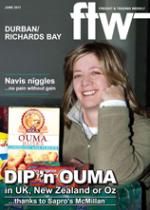‘Relatively flat’ is how
Safmarine describes shipping
volumes out of the Port of
Durban during the first quarter
of this year – with a rather
challenging trade environment
for South African exporters,
although inbound volumes
have increased.
“The strong rand and
high crude oil prices have
placed additional pressure on
exporters,” says Roy Ramdiyal,
Safmarine’s Kwazulu Natal
regional manager.
And adding to South African
shippers’ woes were the
teething problems experienced
by the recent introduction
of Transnet Port Terminals’
new IT system, Navis, at the
Durban Container Terminal.
“Teething problems are to
be expected when introducing
any new system. And the
impact of these problems was
felt throughout the industry
as container moves dropped,
vessels were delayed and
landside productivity in the
port was affected. The good
news is that a lot of focus
was placed on resolving these
problems.
“As Safmarine we tried to
minimise inconvenience to
our customers as a result of
the system’s implementation
by having staff on duty afterhours
to assist our customers
with any Navis and other
associated issues they may
have experienced outside of
our standard business hours.”
Ramdiyal says there’s been
an overall improvement in
productivity and performance
levels in the Port of Durban,
especially the interface
between the port and the road
and rail networks.
But, although there’s light at
the end of the port productivity
and Navis tunnels, Ramdiyal
remains concerned about the
high crude oil price and its
impact on exporters.
“Unfortunately there’s little
we as Safmarine can do about
the oil price other than to
be transparent in our charges
to our customers.
“We have done this by
implementing a BAF calculator
which is available to all our
customers via our website.”
High crude oil prices force up shipping costs
10 Jun 2011 - by Staff reporter
0 Comments
Durban 2011

10 Jun 2011
10 Jun 2011
10 Jun 2011
10 Jun 2011
10 Jun 2011
10 Jun 2011
10 Jun 2011
10 Jun 2011
Border Beat
25 Jun 2025
17 Jun 2025
